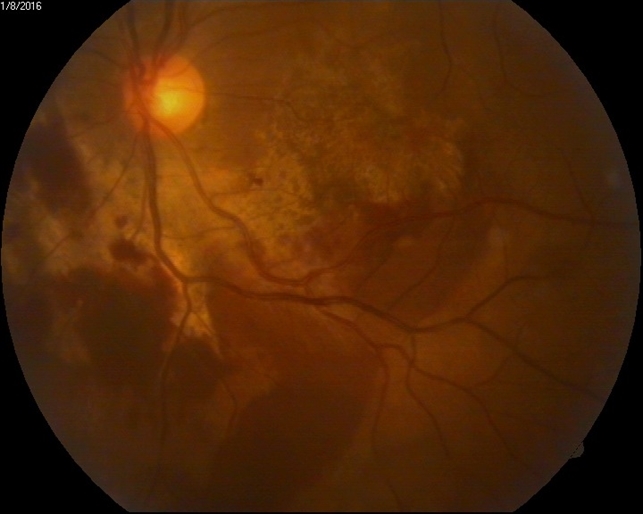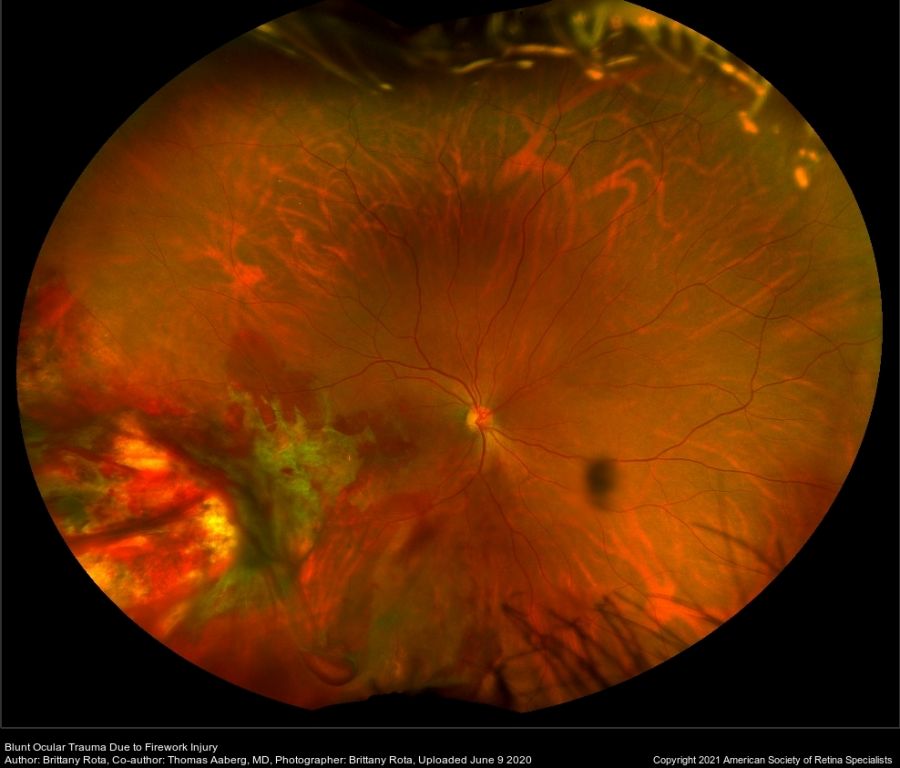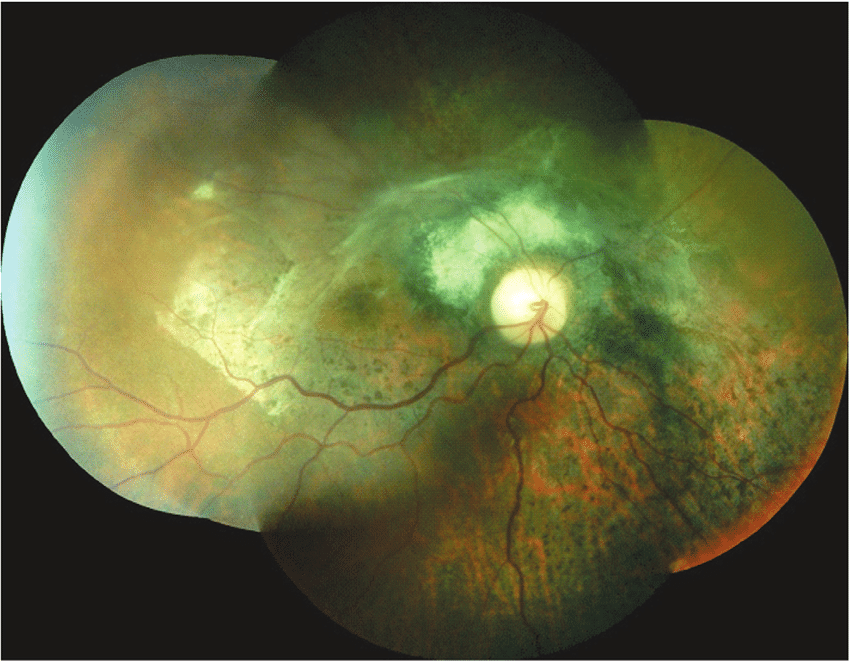CASE REPORT
A 12- year- old boy with a history of BB gun injury to his right eye was referred for loss of vision. His visual acuity was counting fingers at one meter in the right eye and with 3+ relative afferent pupillary defect (RAPD).
On slit lamp examination, the right eye appeared normal except for a 1+ vitreous reaction. Fundus examination of the right eye revealed a pale disc with a superior retinal scar and diffuse submacular fibrosis compatible with chorioretinitis sclopetaria.

DISEASE
Chorioretinitis sclopetaria is a closed globe injury causing a full-thickness rupture of the choroid and retina due to blunt trauma from a high-velocity object such as a bullet passing very close to the globe.
Chorioretinal layers split and retract from the sudden strike of the object while the sclera remains intact. Chorioretinitis sclopetaria is a type of coup injury which means the damage is present at the site of impact.
When a high-velocity object passing adjacent to the globe, the direct and indirect shock waves forces cause the chorioretinal layer to rupture followed by vitreous hemorrhage. The retinal pigment epithelium undergoes hyperplasia with extensive loss of photoreceptors.

Later on, when the blood absorbs the white fibrous tissue is formed at the site of rupture which is then replaced with dense connective tissues resulting in scarring. The scar has irregular borders like a claw. There is no open globe injury and Intraocular pressure remains within normal limits.
Signs and symptoms of Chorioretinitis Sclopetaria
The decrease in vision and severity of pain depends upon the site of rupture and severity of pain. The patient either complains of blurry vision or loss of vision.
Other findings on dilated fundus examination are areas of bare sclera with adjacent tearing of the retina and choroid, vitreous and subretinal hemorrhages, macular edema, choroidal breaks, and disc edema. After some days fibrous tissues can be seen at the site of chorioretinal hemorrhage on fundus examination when blood is completely reabsorbed.
It is believed that the scar formation at the site of impact would prevent retinal detachment. That’s why in chorioretinitis sclopetaria, the chances of retinal detachment are very low. However, in case of severe orbital injury, the retina could be detached.

Diagnostic procedures
The detailed fundus examination of chorioretinitis sclopetaria can be performed on a slit lamp. However, there are some other diagnostic instruments that can provide further details
- OCT: shows choroidal rupture, the thickness of Retinal pigment epithelium, and retinal detachment.
- B-Scan Ultrasonography: visualizes the vitreous hemorrhage and retinal detachment.
- Fundus Fluorescein Angiography: shows hypofluoresence in the area of chorioretinal rupture.
Chorioretinitis Sclopetaria MANAGEMENT
There is no specific treatment is available for chorioretinitis sclopetaria. The patient should be kept on observation and in case of any complication like globe rupture and retinal detachment surgery should be performed.
However, this may not improve visual acuity.
Would you have interest in taking retina images by smartphone?
Fundus photography is superior to fundus analysis as it enables intraocular pathologies to be photo-captured and encrypted information to be shared with colleagues and patients.
Recent technologies allow smartphone-based attachments and integrated lens adaptors to transform the smartphone into a portable fundus camera and Retinal imaging by smartphone.
RETINAL IMAGING BY YOUR SMARTPHONE
REFERENCES
- Sampedro A, Alonso Alvarez C, Ruiz rodriguez M, Usabiaga Bernal JM, Rodriguez vazquez M: Traumatic maculopathies. Arch soc Esp oftalmol. 2001, 76 (1): 57-60.
- Dubovy SR, Guyton DL, Green WR: Clinicopathologic correlation of chorioretinitis sclopetaria. Retina. 1997, 17 (6): 510-20.
- Ludwig CA, Shields RA, Do DV, et al. Traumatic chorioretinitis sclopetaria: Risk factors, management, and prognosis. Am J Ophthalmol Case Rep. 2019;(39-46):39. doi:10.1016/j.ajoc.2019.02.004.
- Shah SU, Prall FR. (2016). Intraorbital Foreign Body Accompanied by Sclopetaria. American Academy of Ophthalmology.
- Dubovy SR, Guyton DL, Green WR. Clinicopathologic correlation of chorioretinitis sclopetaria Retina, 17 (6) (1997), pp. 510-520
- Sadda SR, Wiedemann P, Hinton DR, Schachat AP, Wilkinson CP. Ryan’s Retina. [Electronic Resource]. [London] : Elsevier, 2018.; 2018.
- Blanch R, Ahmed Z, Sik A, et al. (2012). Neuroretinal cell death in a murine model of closed globe injury: pathological and functional characterization.
RETINAL IMAGING BY YOUR SMARTPHONE

RETINAL IMAGING BY YOUR SMARTPHONE


Can you write more about it? Your articles are always helpful to me. Thank you!
Thank you for being of assistance to me. I really loved this article.